Samuel Payne
final lap
May 8 - June 15, 2014
Opening Reception: Saturday, May 17, 7-10pm
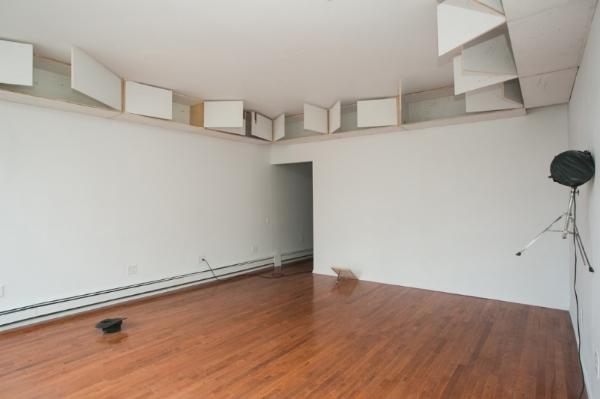

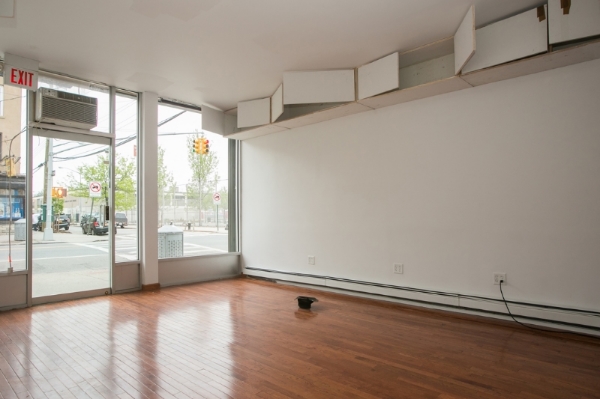


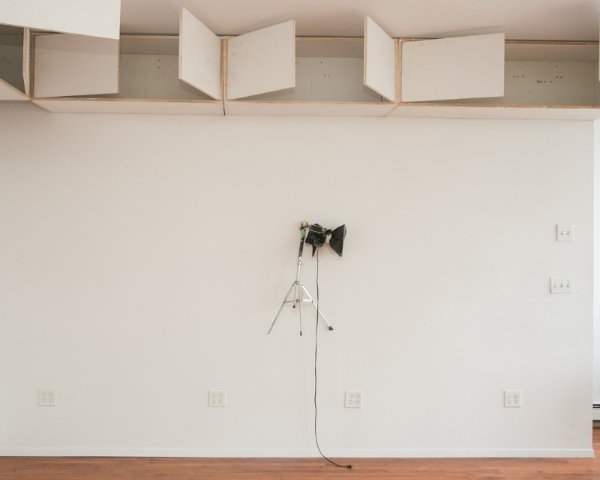

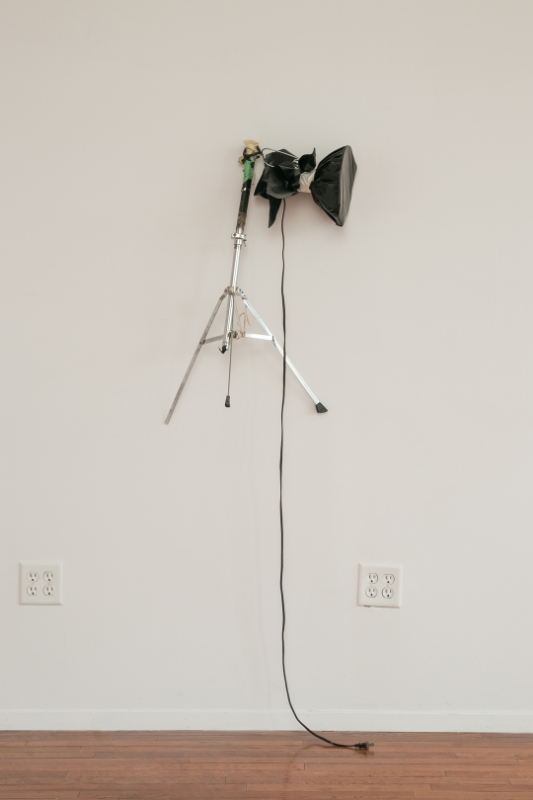

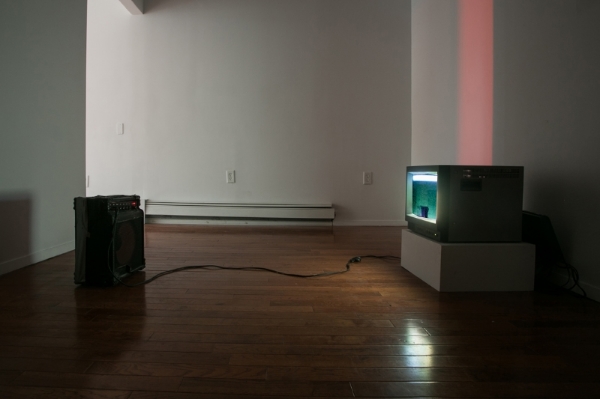
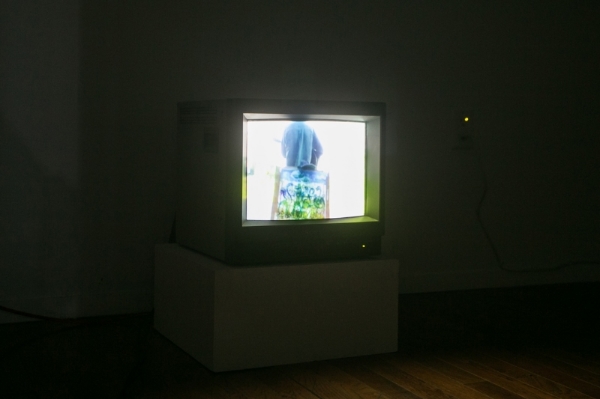
Press
"Night Bloom: New Work by Samuel Payne" by Matthew Hassell, NY Arts Magazine
Objects, contained: objects are things (begin to have use) by virtue of the suggestion of storage (where things go).
Categories, containers: Empty containers imply what they contain – are not empty; instead, are physical spaces for assembling imagined objects and sounds (e.g.: painting the idea of a body, not a body / the opening of a door that is already open, swings out, pivots).
1.
If I begin with the cabinets and trace their etymology to the advent of the cabinet in 16th century France, I’m in a small, private, personal room. Soon the room becomes a placeholder for the things inside of it, a repository for treasures or objects of some kind – they call for silence, sunlight. From this architectural frame, the cabinet is reformulated to denote a piece of furniture. Dis-identification of the subject inside the cabinet is wrung inside out, reversed, and repurposed. Cabinet comes to encompass a meaning inside of itself –is transferred to the objects contained, the subject outside.
The subject is outside and there are no objects inside. The subject is displaced from the interior. Now the subject reaches toward the cabinet. The cabinet is quite high up on the wall. It appears to be within arm’s reach – suspended at arm’s length. Its proximity is teasing, but also teases out a space – a clearing, an opening. There are many cabinets and the cabinet doors are swung open at different angles, revealing a rhythmical, repetitious emptiness that surrounds the room (gallery). The gallery walls are white, but open doors cast shadows stark as the sun shines through, hold time in their place. I crane my head slightly, bow it slightly. The cabinets are high up and if I spin around to see them all in one swirl, the panorama is dizzying. When I stop spinning the cabinets are still there, the room is still here, I’ve held my arms up, I’ve been having some kind of epiphanic (transcending) dream: objects making their way through the room, inside of my head, outside in the world, back onto themselves. I’ve held myself at arm’s length, holding my self and looked at my shadow, witnessed consciousness forming. The subject position (formation) is somewhere in the middle. The middle is the teased-out space, the opening.
2.
Darwinian cabinets – unlike cabinets of curiosities (systematically boundless, with characteristically uncategorizable contents) -- are categorically organized. Each thing in its right place, each thing evolved to refer back to its place: labeled, stored, retrievable. Cabinet drawers pull out to reveal a world where classification signals progressive evolution, itself proof of a displacement through successive changes and substitutions. Evolutionary and retrogressive movements pull apart the fabric of space. Value rises just as buoyant or sinking bodies in water is a material substrate: it tells us something about the equality or difference of the object and its surrounding material. The displaced gain distance and come to occupy other spaces (shadows).
The periphery is pulled into the center, snapped into inchoate place by a song. The dimension of the song is the shape the song makes when it enters the room, how it moves through the center of the framework, and is drawn to its threshold to lie in the door that swings, casting a shadow: that is how it is heard. The multiplicity in the center makes it as liminal a space as the doorframe. The peripheral center is where coexistence means circling back onto the self to end up outside of it or its workable framework, instead framed from the back, stacked inside and out like Russian dolls.
3.
“Form does not necessarily achieve closure, nor does raw materiality provide openness. Indeed, the conjunction of form with radical openness may be what can offer a version of the “paradise” for which writing often yearns—a flowering focus on a distinct infinity.” (Lyn Hejinian, “The Rejection of Closure,” 1985).
The work doesn’t prescribe a closed reading; its radical openness surveys an impasse, migrates within it, from proposition to proposition, causing a revealing displacement akin to Archimedes’s principle. The formal aporia remains willfully unresolved. The work rises to reach a stopping point. Cabinets and objects point outside of themselves and mirror each other in this point, peripatetically arriving at it from different paths. At this stopping point, their refusal of closure is maximal; relative to one another, refusal reverberates. Reverberation, unlike causation, is a trickling, rhythmic, excitatory mode. Coupled with the intentional object, which incites consciousness of itself (be it physical or imaginary), this reverberation opens up what Gaston Bachelard has termed “a threshold of being,” or a middle, a clearing. In the clearing, the work signals a drop: falling flat as a strategy of being.
4.
Tomorrow might not come, so the chess player sacrifices his queen in a swift and radical rupture of the course of the game – opens it up, collapses potentiality and actuality. In a game where strategy equals a linear course, ie: each move entails the next to reach the end, like each note within a song disclosing its intrinsic, necessary successor in the interest of the sequence constituting a whole, the sacrifice of the queen is a note that rings off, that creates an off-course that is not off-course. The pacing of each thing in relation to the other (not necessarily to the next) is upended, even as the rhythm between things feels relational, which is to say, establishes trust, care. Formal, final cohesion is withheld yet there is the evocation of a final pushing forward, followed by gyroscopic returns, rather than linear conclusions or movement within a closed circuit. Incomplete cycles are worth paying attention to, like the multi-generational migration of Monarchs, many of whom never reach their destination: the migratory course is a life, the life is open to its end. When the form of a thing implies a radically open, yet in some way, uncommunicative end (the game of chess is lost), the thing continues to move outside of itself, arriving somewhere that subjective structures had not foreseen.
Decoys and distractions suspend the work at the threshold: “one stays in it, one holds on longer.” In it is also everywhere that is not in it (“not from not / but in in.” – Creeley): negative and positive spaces, recursive mirrors. The relation of parts to each other and the relation of parts to a reticent whole, suggest an unfixed position on a projection plane which hovers between the distant and the proximate. In this, the work moves through decoys and distractions, favoring a multiplicity of positions and a difficulty in difference, that invites a process of breaking apart & a process of reconstructing and re-membering.
-Rachel Valinsky
Samuel Payne (b. 1982, New York City), lives and works in Brooklyn. He earned his MFA in painting at the University of Washington in Seattle, and his BA at Hampshire College in Massachusetts. An album and artist book related to his two-year long cabinet project are forthcoming.
